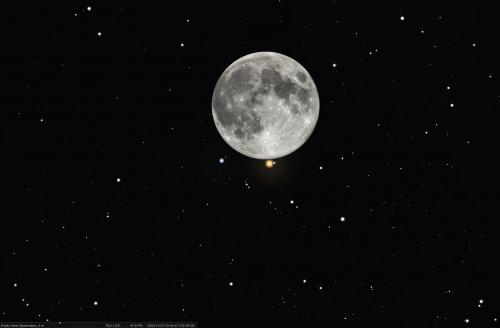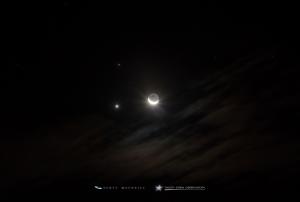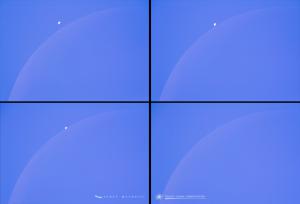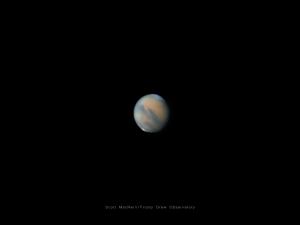Celebration of Space - December 2, 2022
This coming Wednesday, December 7, 2022, at 11:10 pm, the Moon will orbit into a position where it will be on the opposite side of the Earth than the Sun. We call this opposition, but you have, more commonly, heard of it as the Full Moon. The December Moon carries the moniker: The Full Cold Moon. Which is somewhat obvious as to why. December is when the real cold of winter starts to kick in. The name has Native American origins, and anyone who is outside at night in December, can certainly find themselves stating that there is a cold Moon tonight.
The December Moon is also often referred to as the Full Long Night Moon, because it is one of the longest full Moons of the year. What we mean is that the Moon will be above the horizon for the longest period of time, compared to other full lunar phases, due to the coming Winter Solstice, which brings the longest period of night to Northern Hemisphere residents. But we think that this could be interchangeable with the January Moon, depending on the date of the full Moon in proximity to the Winter Solstice. European pagans would refer to the December Moon as the Moon Before Yule, as it is the closest full Moon to the yuletide celebrations associated with the Winter Solstice. Regardless of how you refer to the December Moon, one thing is for sure, it will probably be one of the brightest full Moons you will see during the year due to how high in the sky the Moon will appear. So step outside on December 7th, and raise a warm glass of wassail to the Full Cold Moon of December – the last full Moon of the year, and gear up for a season of festivities and revelries as we close out the year in full out celebratory mode.
There is a fantastic conjunction of Mars and the Full Moon coming to the night sky on Wednesday, December 7, 2022, and depending on where you are observing from, it could end up being a fabulous occultation.
Conjunctions happen when two or more bright objects become close enough, visibly, in the night sky to become noticeable because of their placement to each other. Occultations happen when a closer object overtakes a further object when looking to the sky. A popular example of an occultation is when a solar eclipse occurs. The Moon will orbit into our line of sight with the Sun and overtake (occult) the Sun. Both of these events generally happen along the ecliptic, which is the path the Sun takes across the Sky, and where most Solar System objects are visible. Planets, and the Moon will move against the starscape, and each other, which can result in stunning conjunctions and the periodic occultation.
On Wednesday night, the Moon, in its orbit, will visibly pass extremely close to Mars. For Southern New England sky watchers, Mars and the Moon will be within 1/10th of a degree of each other. Though depending on where you are in greater New England, you may observe the Moon overtake and block your view of Mars. To view the event, all you need is to step outside and look to the sky. All night, Mars and the Moon will be very close to each other, though the best time to observe the conjunction will be around 11:00 pm. Now if you are north of the graze line (which is where observers can view Mars graze along the edge of the Moon, dropping in and out of lunar topographic features) then you will be able to observe the occultation. Timings of Mars’ disappearance, and reappearance are dependent on your location. But disappearance will not happen before 10:30 pm for New England, with the occultation continuing for mere minutes if observing near the graze line, and up to one hour for sky watchers along the Canadian border.
Take a look at this map, which shows the graze line. If you are south of the graze line, you will experience the conjunction, if you are north of the graze line you will experience the occultation too. If you are within the red and blue lines, then you are on the graze line and will experience Mars graze along the south edge of the Moon. Good luck with your viewing endeavors, and let us know if you happen to see the conjunction / occultation that night.
It would appear that December 7 and 8, 2022 are really putting on the astro show this year, as the opposition of Mars will occur on December 8th. The opposition of Mars happens when Earth passes Mars in our orbit, placing Mars on the opposite side of Earth than the Sun. Not only does this place Mars near its closest point to us, but also puts Mars into best viewing.
Of all the planets we observe in the night sky, Mars is the only one that we get every other year. This is due to Mars having an orbital period that is one month shorter than two times that of Earth. Mars’ orbital period is 687 days long, with Earth’s being 365.25 days. Because of this, when we pass Mars in our orbit, and complete a successive full orbit around the Sun, Mars is no longer at the position of opposition, but is now on the opposite side of the Sun. This places Mars into our daytime sky. We need to complete another orbit around the Sun to get back to the opposition period of Mars. But what does all this mean for the regular sky watcher?
Mars will become the brightest object in the sky after Jupiter and the Moon. Mars is very discernible as it has a noticeably reddish hue. When looking at Mars with the naked eye, you will also notice that Mars has a visible disc. Meaning that you can see the surface area, making Mars look round and planet-like, unlike stars that are just super bright points of radiating light. Binocular observations will show even more of the surface area, but Mars is so bright that surface features become difficult to spot. Telescope observations will bring out many of the surface features that you see in images, including planitia, maria, dormant volcanoes, and sometimes the polar ice caps. Depending on your telescope, the view could be very bright. At Frosty Drew we often use a light yellow filter to help bring out surface detail in the view. In any case, you can’t miss Mars in the sky. Once opposition has passed, Mars will rise before sunset, becoming easily visible in the sky earlier each night as we move through the holiday season.
So make plans to get out and see Mars, either in your front yard, or at one of the local observatories in Rhode Island that will be hosting Mars viewing opportunities in their large telescopes over the next month. Because you will not get another chance to see Mars like this until January 2025.
Evening passes of the International Space Station (ISS) will continue this weekend and coming week, ending on Thursday, December 8th. Here is a list of notable passes of the ISS over our region for the coming nights:
Fri, Dec 2 at 5:18 pm, starting in the NW, rising to 23º, heading towards the NE, and into orbital sunset.
Sat, Dec 3 at 6:06 pm, starting in the NW, rising to 57º, and into orbital sunset ← Awesome pass!
Sun, Dec 4 at 5:18 pm, starting in the NW, rising to 43º, heading towards the E, and into orbital sunset.
Mon, Dec 5 at 6:07 pm, starting in the WNW, rising to 40º, heading towards the S, and into orbital sunset.
Tue, Dec 6 at 5:19 pm, starting in the WNW, rising to 73º, heading towards the SE ← Awesome pass!
Wed, Dec 7 at 6:08 pm, starting in the W, rising to 14º, heading towards the SSW.
Thu, Dec 8 at 5:19 pm, starting in the WNW, rising to 25º, heading towards the S
We also have China’s space station – Tiangong putting on stunning evening passes through the next week for our location. Tiangong has grown quite large over the past couple of years, and is now very bright in the sky when it passes, and easily visible. Here are some notable Tiangong passes over our region for this weekend and coming week:
Fri, Dec 2 at 5:56 pm, starting in the WSW, rising to 75º, and into orbital sunset ← Awesome pass!
Sat, Dec 3 at 4:58 pm, starting in the WSW, rising to 56º, heading towards the E, and into orbital sunset ← Awesome pass!
Sun, Dec 4 at 5:37 pm, starting in the W, rising to 89º, heading towards the E, and into orbital sunset ← Awesome pass!
Mon, Dec 5 at 6:16 pm, starting in the W, rising to 49º, and into orbital sunset.
Tue, Dec 6 at 5:19 pm, starting in the W, rising to 86º, heading towards the E, and into orbital sunset ← Awesome pass!
Wed, Dec 7 at 5:58 pm, starting in the W, rising to 68º, and into orbital sunset ← Awesome pass!
Thu, Dec 8 at 5:01 pm, starting in the W, rising to 84º, heading towards the E ← Awesome pass!
This is obviously the week to be out to catch a view of Tiangong passing over in the evening, with so many amazing passes happening. Orbital sunset occurs when the station in view orbits into Earth’s shadow. During this time the residents of the stations will experience sunset, and sky watchers down here on Earth will witness the station quickly fade from view. So, add these sightings to your calendar, as well as to your list of awesome space-based happenings to enjoy this week, and become acquainted with that inner geek that wants to be set free.
- Author:
- Scott MacNeill
- Entry Date:
- Dec 2, 2022
- Published Under:
- Scott MacNeill's Columns






